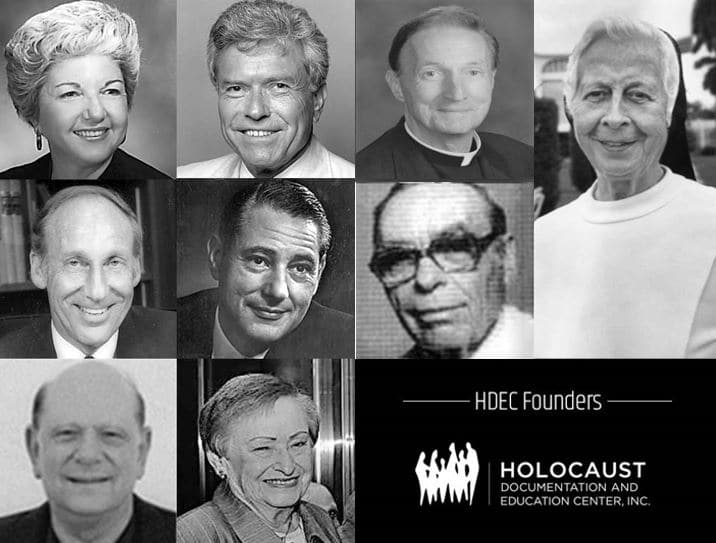Our History
The Holocaust Documentation & Education Center (HDEC) was created in 1980. Its Founders, the late Arnold Picker and Abe Halpern, envisioned the HDEC as “A Living Memorial through Education” – through the collecting and archiving of Holocaust eyewitness oral history testimonies (Oral History Collection). From its inception the mission of the HDEC was embraced in its name: to document and educate.
The Founding President, the late Sister Trinita Flood of Barry University, invited every South Florida College and University president to join the Board of Directors. This remarkable partnership still continues today.
We are delighted that the current Chairman of the Board is Father Pat O’Neill, one of the original Founders of the HDEC.
Building the First South Florida Holocaust Museum –
A Legacy of Remembrance
Building the Museum could not be more urgent, more timely, or more necessary. At the HDEC, we have learned over the past four decades that a Museum is not just a collection of things. It is a place for oral history, photographs, documents, and artifacts which are organized in a manner that documents and educates to convey our message of NEVER AGAIN.
As the generation of Survivors age and their stories continue to be denied, distorted and dejudaized, there is an urgency to ensure the truth. If not now, when? In light of the dramatic growth of global hatred and antisemitism, it is critical that we alert our students and others to be vigilant, speak out, take a stand and understand the meaning of NEVER AGAIN.
South Florida is home to the world’s third largest population of Holocaust Survivors. To date, the HDEC has interviewed over 2,400 eyewitnesses to the Holocaust. To date, the HDEC is recognized as having the world’s largest self-produced, standardized Oral History Collection.
The Museum will feature the HDEC Oral History Collection and special attention will be given to the story of what happened as the infamous ship, the S.S. St. Louis, sailed past the shores of Miami Beach.
The history of the Holocaust conveyed at the Museum is appropriate for ages 11 and older, with parental discretion advised. The Permanent Exhibition design will take an interactive, multimedia, state-of-the-art approach featuring interactive displays and holograms. The Museum, the first in South Florida, is slated to become the first in North America to tell the history of the Holocaust in English and Spanish throughout the Permanent Exhibition.
The Museum will provide a unique opportunity for students and others to understand how hatred, prejudice, bigotry, and evil, if left unchecked, can lead to genocide if one remains silent and indifferent.
The Museum is being conceptually designed by a group of scholars, historians, Survivors, in consultation with the HDEC Board of Directors and the design firm of Gallagher and Associates. To learn more about Patrick Gallagher and Gallagher & Associates please click here.
For more information about the Museum, you are invited to explore our website, or for any questions, please call the Holocaust Documentation and Education Center at (954) 929-5690 or email info@hdec.org.

(L to R) Goldie R. Goldstein (Community Leader), Dr. Gregory B. Wolfe (Former President, FIU*), Father Pat O’Neill (Founding President, St. Thomas*), Sister Trinita Flood (Former President, Barry*), Dr. Abe Fischler (Former President, NSU*), Arnold Picker (Film Industry Executive*), Abe Halpern (Community Leader), Harry “Hap” Levy (Community Leader) and Rita G. Hofrichter (Holocaust Survivor).
*FIU: Florida International University; *St. Thomas: St. Thomas University; *Barry: Barry University; *NSU: Nova Southeastern University; *Film Industry Executive: Columbia Pictures & United Artists.
As the late and beloved founder of the HDEC, Arnold Picker so eloquently noted in 1980:
“It is only the beginning. There is no end to the story. It will go on and on and on. And unless this process of education goes on, past all of us, past our children and grandchildren, it will all have been in vain. The power of this living education must go on. What we are attempting to do is make permanent the record of the history that shall not be forgotten.”
